MileValue is part of an affiliate sales network and receives compensation for sending traffic to partner sites, such as CreditCards.com. This site may earn compensation when a customer clicks on a link, when an application is approved, or when an account is opened. This compensation may impact how and where links appear on this site. This site does not include all financial companies or all available financial offers. Terms apply to American Express benefits and offers. Enrollment may be required for select American Express benefits and offers. Visit americanexpress.com to learn more. All values of Membership Rewards are assigned based on the assumption, experience and opinions of the 10xTravel team and represent an estimate and not an actual value of points. Estimated value is not a fixed value and may not be the typical value enjoyed by card members.
Earning points and miles is relatively straightforward, but the redemption side can be more challenging and complicated.
Most of us share the desire to obtain good value for our points and miles, but it’s hard to know what that means given constant changes in the points and miles environment. Internet searches about the value of points and miles show a wide range of values and often don’t provide details about how that value was determined.
So, let’s address the underlying question about the value of United Airlines MileagePlus miles by using a bottom-up approach that includes:
- Providing background about MileagePlus awards
- Discussing factors that should be considered when redeeming miles
- Describing a mathematical formula to determine the value of MileagePlus miles and demonstrating its use with specific award examples
- Considering MileagePlus valuations that commonly are used within the points and miles community

United MileagePlus Overview
MileagePlus is United Airlines loyalty program. Our MileagePlus guide provides more details about the program including ways to earn and redeem miles and information about elite status.
Like most airline loyalty programs, redeeming miles for flight awards usually is the most valuable way to use MileagePlus miles. The approach and examples below focus on using MileagePlus miles to book award flights on United and its partners, rather than redeeming miles for other uses.
United is one of the largest airlines in the United States, and as a member of Star Alliance, it’s part of the world’s largest airline alliance. This makes MileagePlus a useful program for domestic and international travelers. United also partners with other airlines that aren’t Star Alliance members.
Current partners and links to details about each partnership are provided on United’s website. United’s airline partners are relevant to redeeming points and miles in two ways. Depending on the terms of each partnership and award availability on specific flights:
- MileagePlus members can redeem MileagePlus miles for flights on partner airlines.
- Partner airlines loyalty program members can redeem partner program points or miles for United flights.
Other MileagePlus program strengths include the ease of obtaining miles and customer-friendly policies regarding mileage expiration and fees. MileagePlus miles don’t expire, and there aren’t any activity requirements. The MileagePlus program doesn’t charge cancellation and change fees on awards, and the program has low award taxes and fees. Low fees result from United not assessing fuel surcharges on their own flights and not adding partner airlines’ fuel surcharges on MileagePlus award tickets.
Mileage Plus Award Rates and Fare Classes
MileagePlus award rates are dynamic, and the program no longer publishes award charts. The result is significant variability in award rates and a situation where it’s difficult to know how many miles you should expect to redeem for a particular flight. Unpublished and variable award rates also allow the program to be less transparent about increasing award rates.
Compared to other programs, United’s award rates generally tend to be somewhere in the middle on a scale of best to worst. Given variability in award rates, it’s important to consider where a specific redemption falls on the spectrum of low to high rates.
United has multiple fare classes. Many fare classes apply to flights paid for with cash, but several are applicable to award flights. There are two basic types of MileagePlus awards: Saver and Everyday, both of which are identified by specific fare classes. The term “Everyday awards” is a throwback to when United had award charts. Although United rarely uses the term now, it encompasses specific fare classes discussed below.
Saver Awards
Saver awards typically require fewer MileagePlus miles, and this award space is available for booking through MileagePlus and partner airlines loyalty programs. Associated fare classes are:
- X and XN for economy
- I and IN for business (including domestic first class)
XN and IN indicate extra award availability for certain elite members and members who hold co-branded credit cards.
When United displays search results, economy Saver fares usually are labeled as “Saver,” but business-class fares usually just show the fare class I or IN.
Everyday Awards
These fare classes can’t be booked through partner airline programs, and awards often require more MileagePlus miles. Fare classes for everyday awards are:
- YN for economy
- ON for premium plus
- JN for business
Award Search and Booking Process
United uses a single interface to search for paid and award flights, and the same search engine shows available options for travel on United, United Express and other partner airlines.
You can begin a search without logging into your Mileage Plus account, but you need to login to see additional Saver award space or award discounts available to elite members and/or co-branded credit cardholders and to complete a booking.
Members can enter flight search criteria on the main flight search page or an advanced search page with more options. To find award flights, select “Book with miles.” The search tool provides an option to view award availability and lowest rates over 30 days in a calendar view and supports filtering on multiple criteria to help narrow down results to desired flights.
If your travel dates are flexible, the 30-day view can be helpful to find dates with lower award rates. From the initial search page, selecting “flexible search” and choosing the month should show the calendar view. In this search, we chose “business” from the dropdown to see business / domestic first-class award rates.
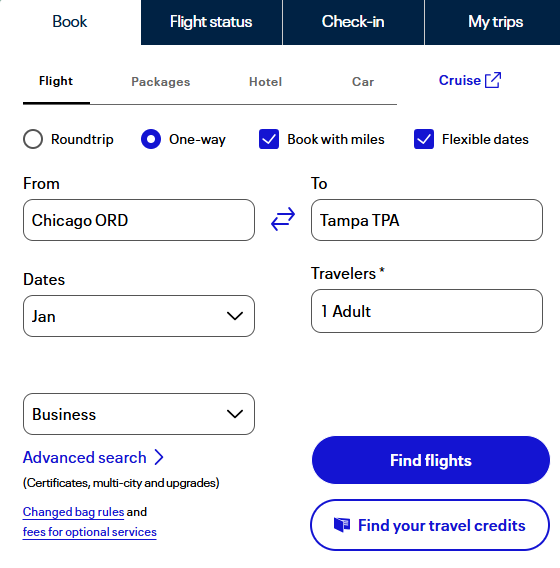
The calendar view defaults to showing flights for the 15th of the selected month, as shown below. Dates with the lowest awards for the 30-day period in the selected class of service are shown in green text and labeled. The arrows near the top let you navigate to the previous or next 30 days.
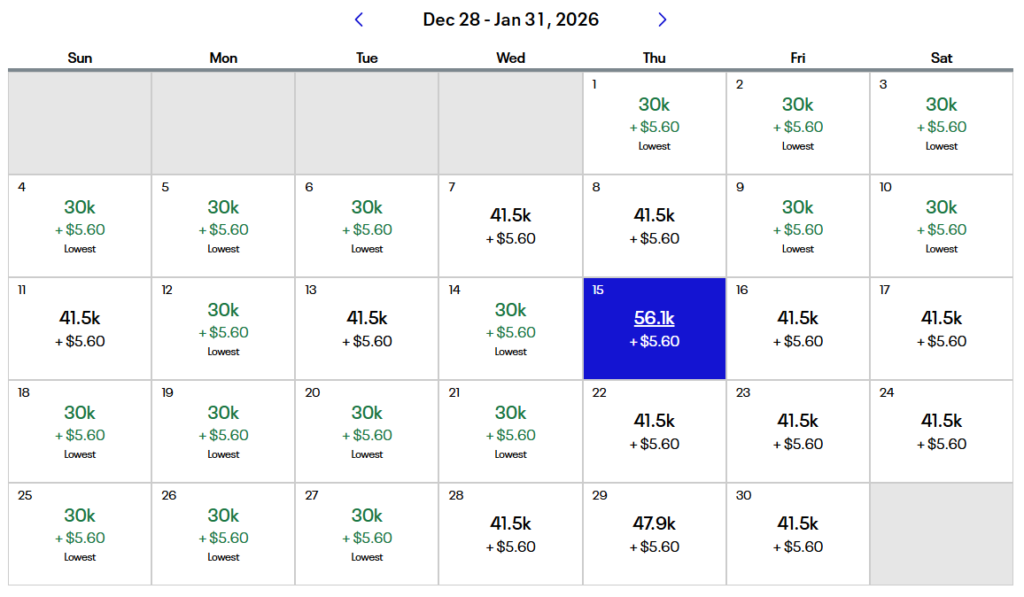
You can choose another date in the calendar view. For example, Jan. 9 is selected below.
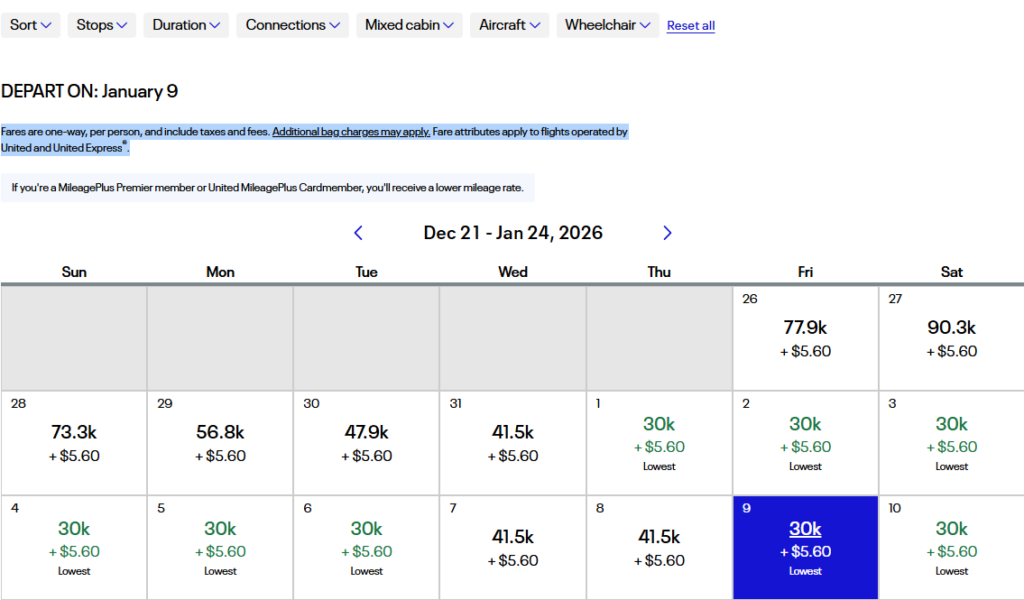
You’ll also find sorting and filtering options above the calendar view, including:
- Sort: The default sort order is “Best match,” which seems to take into account itinerary duration and rates. Other sort options are number of miles for each available class of service, travel time, arrival time, departure time and number of stops.
- Stops: This is particularly useful if you’re looking for nonstop flights or want to limit the number of flights on connecting routes.
- Mixed class: The default is to show mixed cabin options, and there’s an option to hide mixed class itineraries. Results labeled as “Mixed class” (applies to premium economy, business or first class only), refer to connecting routes where award availability on one or more flights is in a lower class of service.
Flights on the selected date are displayed by scrolling down. This example shows some results for Jan. 9 in the default sort order.
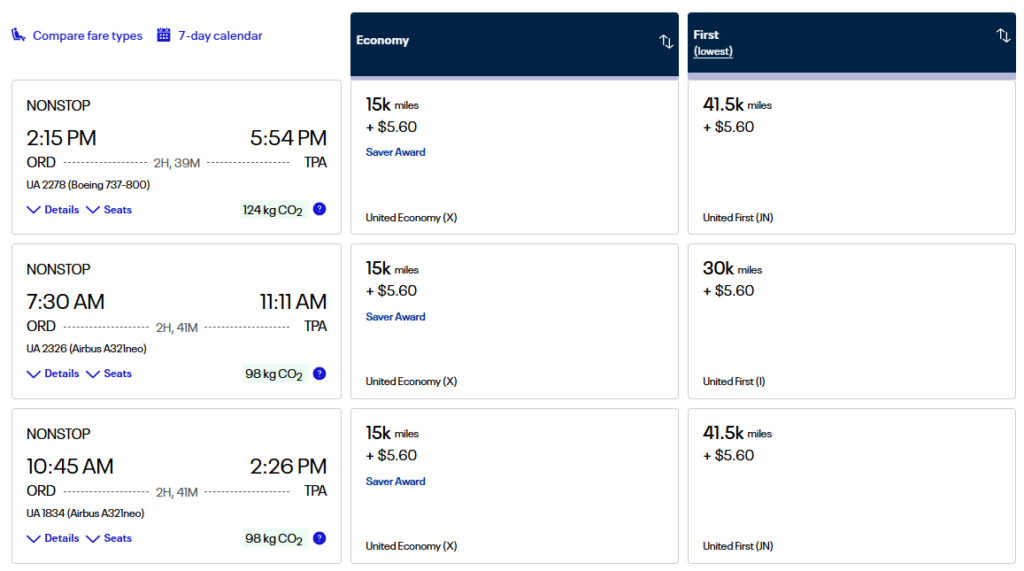
We’ll take a closer look at the details later.
Another notable feature is that you can change your basic search criteria at the top of the screen. This includes options for viewing rates in money, miles or a combination of the two.

In the MileagePlus basics guide, we discussed an example showing that the “Money + Miles” option reduced cash prices by $10 per 1,000 miles used. This is like redeeming miles at a value of 1 cent each.
Award Redemption Considerations
There are many factors that contribute to some redemptions providing better “value” than others. Some factors are more controllable than others.
Redemption Valuation Basics
To begin, let’s clarify what points and miles enthusiasts mean when discussing redemption value and explain how it’s determined. Redemption value refers to a cents per mile (cpm) or cents per point (cpp) number. Since MileagePlus currency unit is miles, we’ll use cpm.
At the most basic level, cpm is the cost of a flight if paying cash divided by the number of miles required for an award flight multiplied by 100. Points and miles enthusiasts can calculate the cpm for flights they are considering and compare that result to a target (desired) or floor (minimum acceptable) cpm to decide if redeeming miles for the flight makes sense or not.
The target and floor cpm values for MileagePlus miles are both personal and situational. As a general rule, we recommend avoiding redemptions that provide under 1 cent per mile. Many points and miles enthusiasts use a higher personal threshold. Considering thresholds as guidelines rather than absolute rules makes sense for many travelers. Sometimes using miles at a lower cpm is a better alternative than spending cash or forgoing a trip due to high award rates.
It’s important to acknowledge that cpm compares costs and doesn’t directly measure value. Value or worth are subjective terms that aren’t easy to quantify. The quantitative cpm measure generally is used as a proxy for describing how much miles are worth.
Relationship Between Cash and Award Rates
There are many factors that influence award and cash rates for flights. Airlines use complex algorithms to determine rates for particular flights.
Higher (or lower) cash rates sometimes are correlated with higher (or lower) award rates, but that’s not always the case. Even when rates are correlated, increases (or decreases) in cash vs. award rates might not be proportional.
As a hypothetical example, let’s consider the same flight on two different days:
- On Day 1, the flight costs $200 cash or is available as an award flight for 20,000 miles (1 cpm redemption value).
- On Day 2, the same flight requires $400 cash or 30,000 miles (1.33 cpm).
Cash and award rates both are higher on Day 2 compared to Day 1, but cash rates from Day 1 to Day 2 double (100% increase), while award rates from Day 1 to Day 2 increase by 50%. Using miles to book flights on Day 2 provides better redemption value compared to Day 1 because the cash rate increased by more than the award rate.
There are more fare types applicable to cash rates than award rates. When searching for flights to purchase with money, you may see columns in search results for basic economy, economy, fully refundable economy, economy plus / premium economy, premium plus, lowest business / first and fully refundable business / first. Deciding which cash fare to use when comparing award and cash rates involves some subjectivity and consideration of personal circumstances.
Refundability may be a consideration for cash fares. Fully refundable cash rates provide refunds to the original form of payment, and so do award tickets. While other cash rates may be refundable, a fee may be deducted and/or the refund might be issued as a credit that expires and only can be used towards future flights.
Saver Fares on Partner Flights
There’s a fundamental difference between Saver fares on United flights and partner flights. As discussed above, some awards on United flights are Saver fares, and others are Everyday fares. All partner airline flights that can be booked through MileagePlus are Saver fares.
Similar to how United makes some award space available to book through partner programs, flights that are operated by other airlines and displayed in United award search results represent space that other airlines make available to MileagePlus members. Saver award flights operated by partners often have less award availability and less rate variation compared to United flights.
Although partner award rates aren’t published, rates seem consistent, at least for flights between certain regions.
For example, identical award rates of 60,500 miles per direction in economy or 110,000 miles per direction in business class were available on partner flights between the U.S. and Asia on the following routes and partner airlines:
- Seoul, South Korea, to San Francisco nonstop on Asiana Airlines
- Seattle to Tokyo nonstop on All Nippon Airlines (ANA)
- Seattle to Singapore on a connecting route with flights operated by Thai Airways and ANA
Other searches performed support the conclusion that partner awards (when available) seem to have consistent award rates between regions. In addition to the rates between the U.S. and Asia mentioned above, partner award rates in economy / business are 44,000 / 88,000 MileagePlus miles for one-way awards between the U.S. and Europe, Middle East and parts of Africa.
Business-class award rates on partner-operated international flights often are more stable and significantly lower than similar United flights that mostly have Everyday award availability. This can result in better redemption value on partner flights.
Class of Service
Since business-class cash rates often are many times higher than economy cash rates, business-class awards have historically provided better redemption value than economy awards. However, this rule of thumb doesn’t always apply with dynamic award rates.
In recent years, Saver award availability on United flights in domestic first class and international business class has been extremely limited, so most United premium cabin awards are based on higher dynamic award rates.
Travel Dates and Booking Timeframe
It’s well-established that specific travel dates and how far in advance you book flights impact cash rates, award rates and award availability. On the other hand, specifying the impact for a given itinerary is nearly impossible because there are so many variables.
Supply and demand dynamics apply, and the busiest travel times—both overall busy travel times, such as Christmas and New Year’s period, and destination-specific peak travel periods—often have high cash rates and high award rates, if awards are available at all.
One mitigating factor is that airlines sometimes add flights increasing supply during peak travel times. An example is that there are seasonal routes and extra flights from the U.S. to Europe during the summer. Whenever additional flights are added, that potentially opens up additional award availability.
Another variable is when United and partner airlines release award space relative to your planning horizon. While some airlines release award space when their booking window opens—typically between 330 to 362 days in advance—not all do. United opens booking 337 days in advance.
For partners that open booking earlier than United and release awards to partner airline programs when their schedules open, MileagePlus members won’t be able to access award space as early as members of certain other programs. In this situation, awards may be gone before they’re available through MileagePlus.
For example, ANA operates high-demand nonstop flights between several U.S. airports and Tokyo. ANA opens booking 355 days in advance. Air Canada Aeroplan is an accessible loyalty program for points and miles enthusiasts because points from many flexible rewards programs can be transferred to Aeroplan. Like ANA, Aeroplan allows booking 355 days in advance, so Aeroplan members can book ANA awards about 2.5 weeks before MileagePlus members.
For United’s own flights, MileagePlus recently hasn’t been opening much Saver award space in premium cabins when the schedule first opens, but economy Saver awards often are released near the beginning of the booking window.
There’s another timeframe where some programs release additional award space, and that’s within two weeks (or less) of travel. Certain United partners release additional award space—including business-class international flights—within this period. One example is the previously mentioned ANA flights to Japan. We found award availability five days before the travel date.
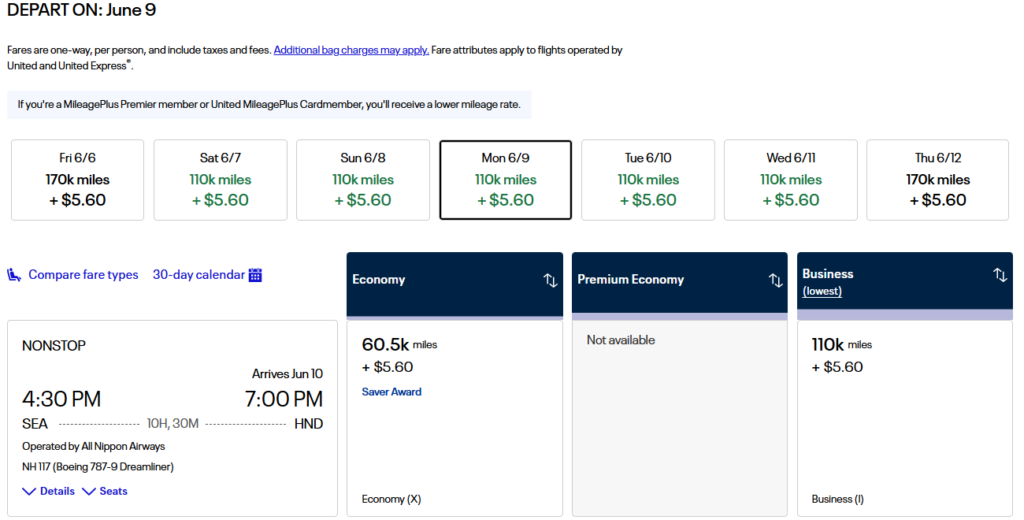
On the other hand, cash and award rates for flights booked close to departure might have higher rates—or award seats might not be available at all—if flights are nearly full.
Specific Itinerary
Airline pricing is highly sensitive to competition. If you happen to live in or travel to a destination that lacks competition, cash and award rates often are higher. On the other hand, for airports or specific routes where United is competing with other airlines, rates may be lower than otherwise expected.
Even when comparing flights from the same origin to the same destination on the same day and same carrier, there may be differences in rates depending on factors such as time of day, number or connections and layover duration. As a general guideline, higher rates are common for flights that most travelers would find more convenient. Some examples include airlines charging higher rates for nonstop routes and departure times that avoid extremely early morning or late evening travel.
Being flexible about an itinerary—including factors such as specific airports, carriers, travel dates, travel times and number and length of connections—may allow travelers to find lower cash and/or award rates.
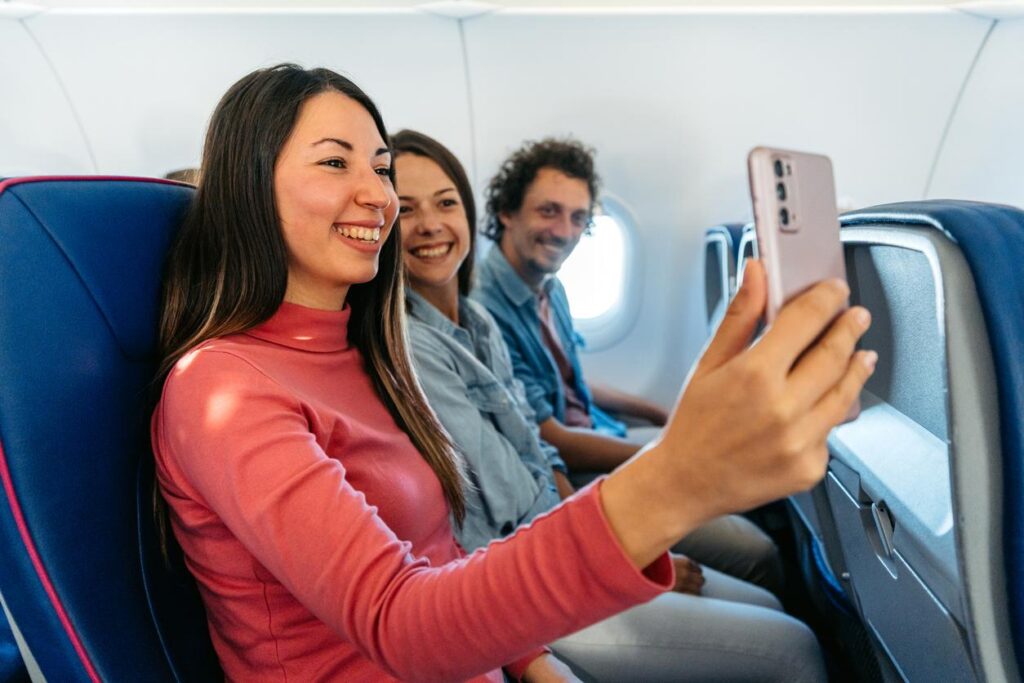
Cents Per Mile Calculation and Examples
Let’s discuss more specifics about the cpm calculation and illustrate the process with some examples.
Calculation Approach Details
To build on the basic cents-per-mile concept discussed above—calculated as the cash cost of the ticket divided by the number of miles for an award ticket multiplied by 100—there are some modifications that make the calculation more precise and customized to personal situations.
- The first refinement—which is generally accepted methodology and easy to implement—is modifying the numerator by subtracting the taxes and fees associated with the award ticket from the cost of the cash ticket. Since MileagePlus awards have low award taxes and fees, this won’t have as much impact as with other programs that have higher taxes and fees, but this adjustment reduces cpm.
- The second potential refinement is to adjust the denominator by adding in the number of miles that would be earned on the cash flight that aren’t earned on the award flight. This is more challenging to implement because miles earned depend on the traveler’s elite status, the airline that operates the flight and the type of fare purchased. This adjustment reduces cpm.
- The third potential refinement involves modifying the cost of the paid flight. The default is to use the cash cost of the same itinerary you’re planning to book as an award. The flaw is that many travelers wouldn’t book the exact same itinerary if paying cash. Travelers may choose to fly on a different airline, book a different route or travel in a different class of service if paying cash. For travelers who would choose different flights if not booking a MileagePlus award, using the cost of the flight that they would book with cash may be more realistic than using the cost of the exact award itinerary. Another consideration is that one-way cash fares on international routes sometimes are significantly more expensive than half of the round-trip fare, so it may be more accurate to use roundtrip rates in cpm calculations.
Our approach is to incorporate the first refinement in all examples, but not make the second and third modifications in most situations. The reason is that the second and third modifications are situational and/or subjective.
The formula (A – B) / (C + D) x 100 estimates the value (in cents) of one mile using the following inputs:
- A = Cash ticket cost
- B = Award ticket tax and fee cost
- C = Number of miles required for the award ticket
- D = Number of miles earned for the cash ticket (not used in examples)
Our examples purposely include a mix of domestic and international flights operated by United and partner airlines. We also chose examples that illustrate some of the factors discussed above. We didn’t cherry pick examples to show extremely high or low cpm results. We also didn’t include examples utilizing United’s Excursionist Perk because the ability to book awards with the Excursionist Perk ended Aug. 21, 2025.
Domestic Awards
Routes entirely within the United States generally involve flights on United and United Express. We’re going to look at nonstop and connecting itineraries and also consider Saver and Everyday awards.
Nonstop Flight Example
Let’s start by looking at results for domestic flights from Chicago to Tampa, Florida, as discussed above.
The lowest award rates on the selected date are Saver awards in economy and first class.
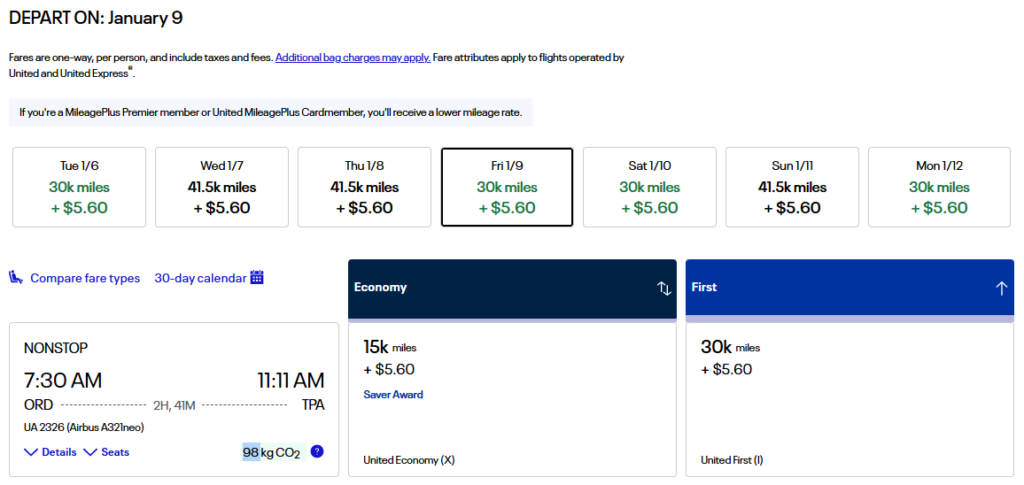
The cash rates for the same flight follow. There are three types of economy fares, and we’re using the regular economy fare for cpm calculations.

Using the formula above, cpm calculations based on award and cash rates for this flight are:
- Economy: ($207 – $5.60) / 15,000 x 100 = 1.34
- First: ($417 – $5.60) / 30,000 x 100 = 1.37
Connecting Flight Example
This is for a route where United doesn’t have nonstop service. All flights from Rochester, New York, to Phoenix have at least one connection. We didn’t see any first-class availability at Saver rates, so the award rates for first class are Everyday rates (fare code JN).
Award rates are displayed below.
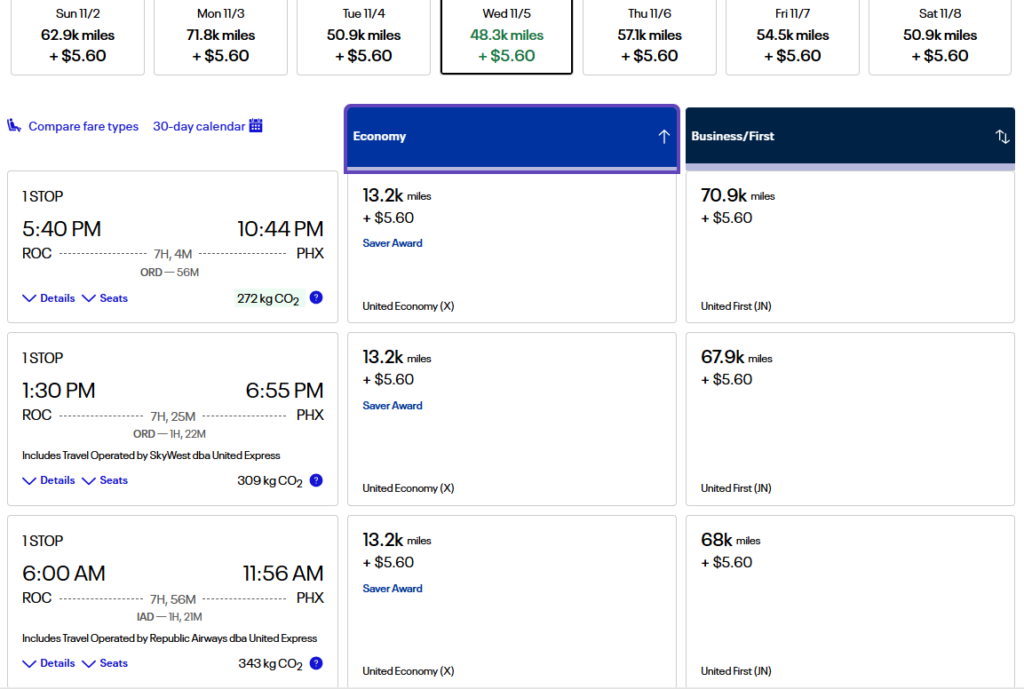
Cash rates are displayed below.
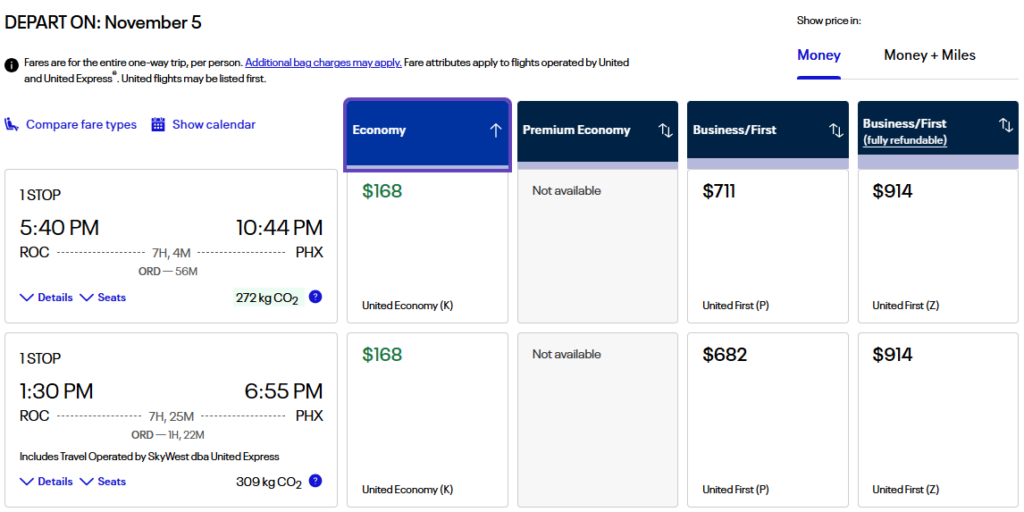
Cents per mile calculations are for the flight departing at 1:30 p.m. We’re calculating business / first cpm using both the lowest cash rate and the fully refundable rate for comparison.
- Economy: ($168 – $5.60) / 13,200 = 1.23
- Lowest business / first: ($682 – $5.60) / 67,900 = 1
- Fully refundable business / first: ($914 – $5.60) / 67,900 = 1.34
International Awards
Determining the value of international awards can be more complicated for several reasons:
- Flights on a single itinerary can be operated by United only, United and partner airlines, or partner airlines only.
- Some itineraries with partner flights are available using miles but can’t be purchased through United’s website using cash.
- Factors that usually don’t increase MileagePlus award rates—such as purchasing one-way tickets or having flights on multiple airlines on a single ticket—sometimes result in significantly higher cash rates.
- Some awards, especially in business class, that are available at Saver rates are for itineraries that have more connections. While travelers may choose these options when paying with miles, a different option might be preferable if paying cash.
One-Way U.S. to Asia Example
United and Asiana both operate nonstop flights between Seoul (ICN) and San Francisco (SFO). On the same date:
- Business-class awards are available for the Asiana flight at the Saver rate of 110,000 miles and for the United flight at the Everyday rate of 148,800 miles.
- Economy Saver (X fare) awards are available on both flights, but the United flight has much lower award rates for economy.
Award rates for the Asiana flight are:
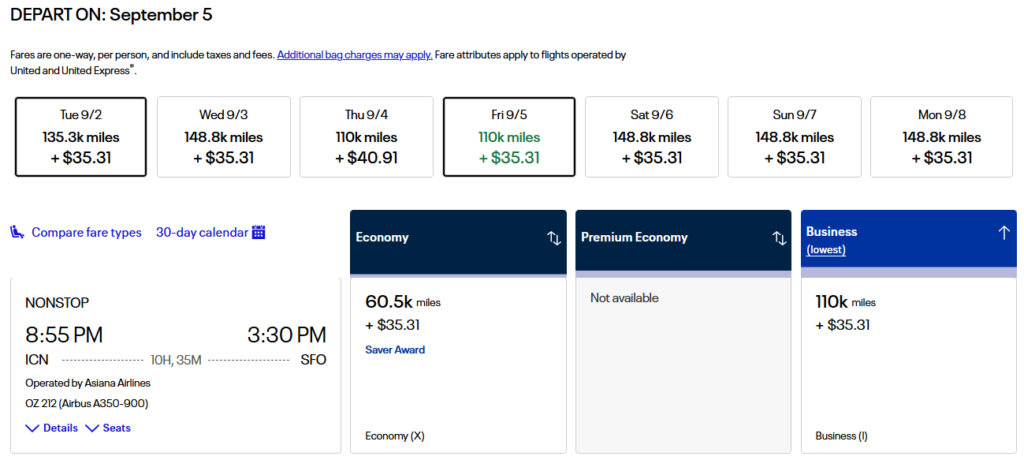
Award rates for the United flight are:

Asiana flights can’t be purchased with cash through United, so we used a third-party site as the source for Asiana cash rates, as shown below. The cash rate is $800 in economy class.

The cash rate is $2,253 for business.

Cash rates for the United flight are displayed below. United shows two fare options for business class. While it’s reasonable to choose the fully refundable fare—because award tickets are fully refundable and this would provide an apples-to-apples comparison—we’re using the lower business fare in these calculations. We believe that most travelers—with one exception being travelers with a high degree of uncertainty about the trip—would choose the lower fare given the significant price difference.

The following cents per mile calculations show Asiana and United flights in business and economy cabins. The fare classes for award flights are in parenthesis.
- Asiana flight – Business (I): ($2,253 – $35.31) / 110,000 = 2.02
- United flight – Business (JN): ($2,231 – $35.31) /148,800 = 1.48
- Asiana flight – Economy (X): ($800 – $35.31) / 60,500 = 1.26
- United flight – Economy (X): -($792 – $35.31) / 36,200 = 2.09
Choosing the Asiana flight provides better value (based on higher cpm) for a traveler who wants to use MileagePlus miles for business-class flights, while the United flight provides better value for award travel in economy.
Round-Trip Between the U.S. and Europe
This example is useful for highlighting several factors related to the subjective nature of valuing miles. The selected route between Newark, New Jersey (EWR), and Zurich (ZRH) has United and Swiss International Air Lines nonstop flights as well as connecting options involving these airlines and other partners. The example is for a one-week trip in August.
For nonstop flights, Swiss flights aren’t available in business class using MileagePlus miles, so the example uses United flights, which are available in both directions in business and in economy cabins.
- Economy: Saver award space is available for economy awards on United nonstop flights for 37,700 miles outbound to Zurich and 42,000 miles inbound to Newark. The total for round-trip award travel is 79,700 miles plus $86.11 taxes and fees. The cash fare for the same flights in economy is $835, resulting in a cpm of 0.94.
- Business: Business-class rates are 150,000 miles for the outbound flight and 200,000 miles for the inbound flight. For round-trip travel, the total is 350,000 miles plus $86.11 taxes and fees. The cash fare for the same flights in business class is $3,545, resulting in a cpm of 0.99.
Let’s look at connecting flights with partner award availability. The situation is different for economy vs. business awards.
Saver rates on economy options on connecting routes are 44,000 miles per direction, so the round-trip miles required exceed nonstop award rates for United flights, and the cash rates are much more expensive for the connecting itinerary. It doesn’t make sense to look at cpm for this scenario because most travelers would choose a nonstop itinerary with lower rates over a more expensive connecting itinerary.
Saver rates in business class are available for outbound and inbound itineraries at 88,000 miles per direction, and we’ll calculate the cpm for specific flight combinations that are available on United’s website for award and cash tickets.
For outbound award flights, the second option (6:45 p.m. departure) is used for calculations.

For inbound award flights, the third option (7:05 a.m. departure) is used for calculations.
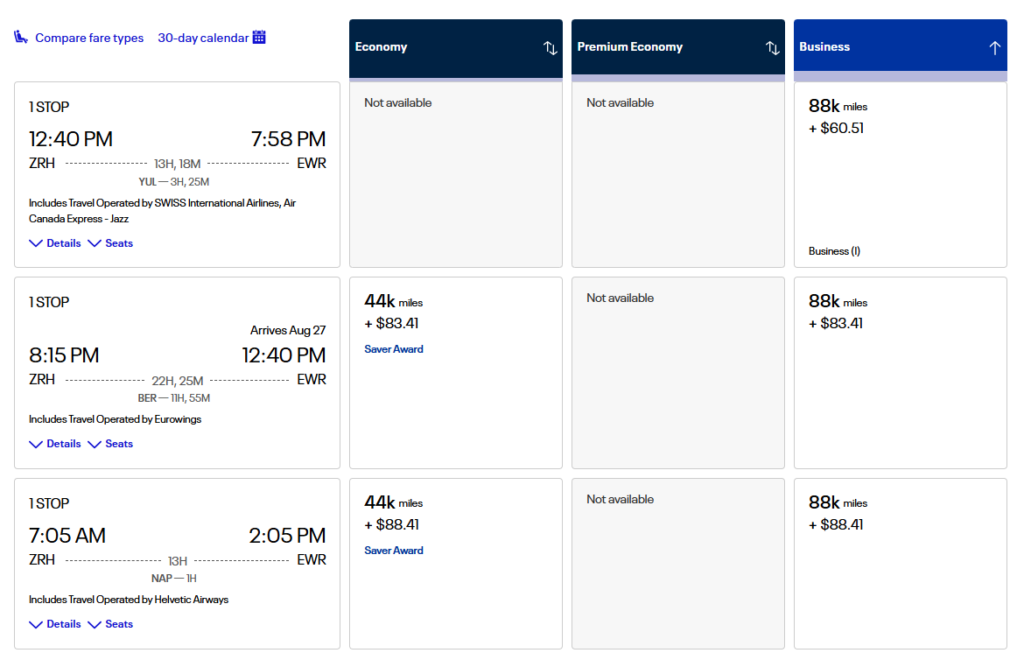
The round-trip cash rates for this combination of flights are shown below.
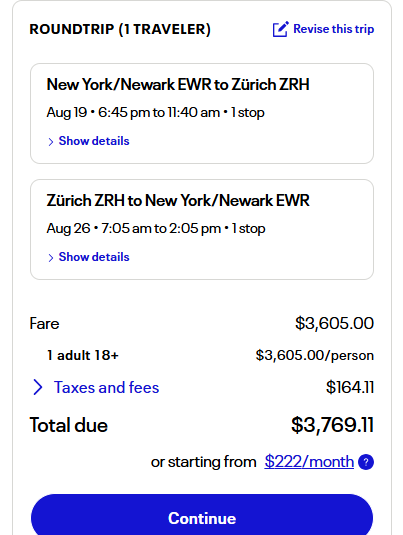
The cash rates for these flights with connections are slightly more than the United nonstop flights shown above. Many travelers would choose the less expensive nonstop flights if paying cash for flights rather than the more expensive connecting flights, so this might be a situation where it would be appropriate to adjust the cash cost to reflect the cheaper cash flight.
Let’s calculate the cpm both ways:
- Business-class one-stop flights using cash cost of same flights: ($3,769.11 – 113.81) / 176,000 x 100 = 2.08
- Business-class one-stop flights with adjusted cash cost to reflect cheaper nonstop flights: ($3,544.51 – 113.81) / 176,000 x 100 = 1.95
MileagePlus Value Ranges
Let’s get back to the central question of how much MileagePlus miles are worth. Award options yield a wide range of cpm numbers. Our examples show a range from just under 1 cpm to just over 2 cpm. Other flights we examined but didn’t discuss fell into the same range. International business-class awards on partner airlines accounted for some of the higher values.
There are some math and statistics concepts relevant to summarizing cpm numbers.
- The mean, also called the average, is the mathematical sum of the observed values divided by the total number of observations. The mean sometimes is criticized for giving too much weight to outliers, especially on the higher end of the distribution.
- The median is the middle value in a series of observed values and represents the point where half the values are higher and half are lower.
Although it’s not valid to calculate statistics with such a small data set, a simple example highlights the difference between using the mean and median. Let’s say that cpm numbers for different redemptions are 0.75, 1.25, 1.3, 1.35, 1.4, 1.6 and 4.35. The mean is 1.72 cpm, and the median is 1.35 cpm.
Another concept applicable to airline awards is weighting the different type and number of redemptions. Although points and miles enthusiasts often focus on awards with higher potential cpm, such as international partner business-class flights, there are significantly more awards available and redeemed in economy on United flights. Weighting can be used to calculate a cpm that considers the number of data points in each category. For example, economy awards should be weighted more heavily than business- and first-class awards.
Since we haven’t examined enough redemptions to generalize our findings, let’s consider analysis from other points and miles sources. We looked at the valuation for MileagePlus miles reported on multiple points and miles blogs and websites during June 2025. Cents per mile values were between 1.1 and 1.94, with most estimates between 1.2 and 1.4.
Two sources that are useful because they utilize and discuss data-driven approaches are Frequent Miler and The Points Guy (MileagePlus value, analysis approach). Their estimated values for MileagePlus miles are 1.3 and 1.35 cpm respectively. They arrive at similar valuations despite using different underlying data, weighting factors and analysis approaches.
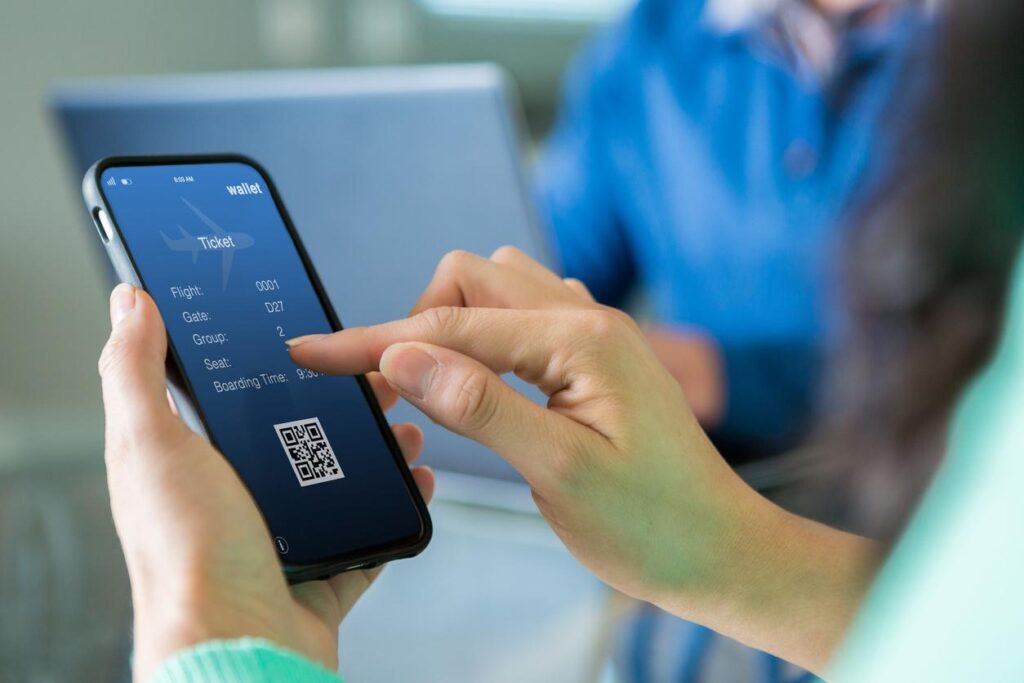
Final Thoughts
It’s important to have a general idea about how much MileagePlus miles typically can be redeemed for when booking award flights. This is an important input for making informed decisions about whether to redeem miles for a flight on United or its partners, book the flight using cash, or use other points and miles to book that flight or an alternative flight. Using the approach discussed above, you can calculate the cents-per-mile valuation for a potential award and use the calculated cpm as an input for award redemption decision-making.
The value of MileagePlus miles is subjective, and cpm isn’t a direct measure of value. Many factors contribute to the value of miles in specific situations, and not all of them are quantifiable. We recommend using MileagePlus miles when it makes sense for you, rather than strictly applying cpm rules to every redemption decision.
Given the wide range of individual preferences and the dynamic nature of cash and award rates for flights, there’s no one-size-fits-all value for MileagePlus miles. Reasonable expectations are:
- It’s relatively easy to find MileagePlus awards that provide a minimum valuation of 1 cent per mile or more, so in most cases, 1 cpm is a reasonable floor value.
- The most commonly discussed valuations of 1.2 to 1.4 cents per mile should be attainable for many MileagePlus members who are intentional about avoiding redemptions yielding the lower end of the range (under 1.2 cpm).
- Points and miles enthusiasts redeeming miles primarily for international premium-cabin seats on partner-operated flights or itineraries that tend to be relatively more expensive using cash than miles may be able to get 1.5 to 2 cents per mile (or more) for these redemptions.

